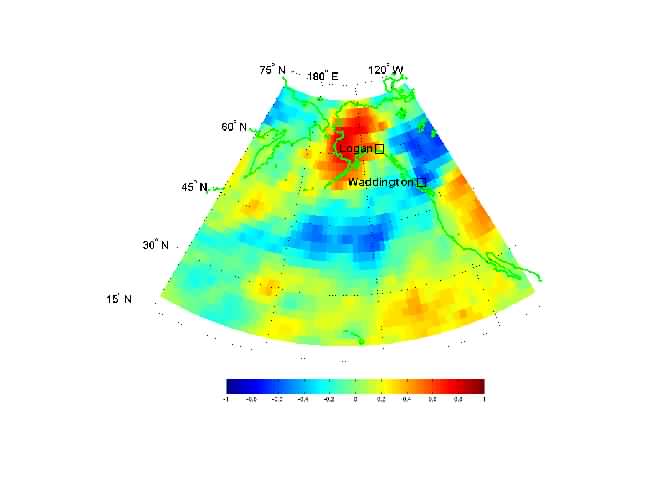
Eric Steig, University of Washington
Doug Clark, Western Washington University
with the Western Canadian Cyrospheric Network

|
Eric Steig, University of Washington Doug Clark, Western Washington University with the Western Canadian Cyrospheric Network |
Why is Waddington a good place to obtain an ice core?
1. Climatology. Calculations by
University of Washington graduate student Summer Rupper show that for
climate reconstrucstion purposes, the Waddington Range is nearly ideally
located with respect to other ice core records available in North America.
The dominant pattern of interannual variabilty in snowfall is a dipole
pattern (associated with the PNA/PDO patterns of atmospheric pressure and
sea surface temperature variability) with Waddington near one pole, and
Mt. Logan (St. Elias Range) at the other.

The figure shows the correlation between annual precipitation and the first principal component of precipitation annual (NCEP) for all land-based grid points in western North America. Locations of Logan and Waddington are marked for reference.
Rupper et al. (2004) showed that the Logan accumulation record reflects winter-time storminess extremes in the Gulf of Alaska, but used alone would provide poor statistics for quantative reconstruction. Using both the Logan and Waddington records together should substantially improve the utility of these records.
2. Glaciology. Simple lapse rate calculations, using data from Bella Coola, Tatla Lake, and Williams Lake (the closest weather stations), suggest that the mean annual temperature at Combatant Col is -5 C. The same result is obtained from the University of British Columbia's climate downscaling model (Wang et al., 2006. Development of scale-free climate data for western Canada for use in resource management. Intl. J. Climatology, 26(3): 383-397). Additionally, while temperatures in summer reach above freezing during the day, it freezes almost every night, even in July and August (it snowed a week before we visited the site in mid August, 2005), and melt layer development in the afternoon sun is minimized by the shading provided by the Waddington massif. It is quite likely that the ice is frozen to the bed at this site -- assuming simple "ice divide flow" (D-J ice flow model with h/H = 0.7), MAT = -5, and 2 m of snow accumulation per year, and a geothermal heat flux of 50 mW/m2the bed temperature should be -1.6 C (see Paterson, 1984, page 203 for details on this calculation). If the geothermal heat flux is higher than we assume, or if the ice is thicker or the accumulation rate lower, the ice may be melting at the bed. Either way, the age of the ice at the bed should be in excess of 200 years, and may be much older.
Publications
Rupper SB, Steig EJ & Roe GH. On the relationship between snow accumulation at Mt. Logan, Yukon, and climate variability in the North Pacific. Journal of Climate 17(24): 4724-4739 (2004).